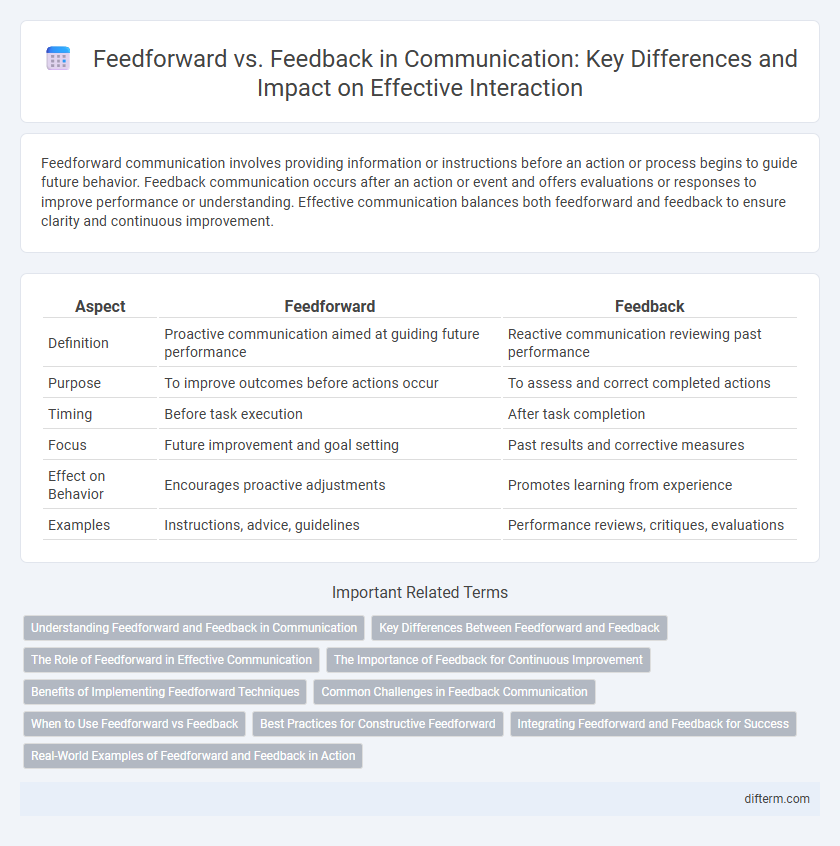Feedforward communication involves providing information or instructions before an action or process begins to guide future behavior. Feedback communication occurs after an action or event and offers evaluations or responses to improve performance or understanding. Effective communication balances both feedforward and feedback to ensure clarity and continuous improvement.
Table of Comparison
| Aspect | Feedforward | Feedback |
|---|---|---|
| Definition | Proactive communication aimed at guiding future performance | Reactive communication reviewing past performance |
| Purpose | To improve outcomes before actions occur | To assess and correct completed actions |
| Timing | Before task execution | After task completion |
| Focus | Future improvement and goal setting | Past results and corrective measures |
| Effect on Behavior | Encourages proactive adjustments | Promotes learning from experience |
| Examples | Instructions, advice, guidelines | Performance reviews, critiques, evaluations |
Understanding Feedforward and Feedback in Communication
Feedforward in communication involves providing anticipatory information or guidance before the main message is delivered, enhancing clarity and setting expectations for effective interaction. Feedback refers to the responses or reactions received after the message is communicated, enabling adjustment and improvement in future exchanges. Understanding the dynamic between feedforward and feedback mechanisms is essential for optimizing communication flow and achieving mutual comprehension.
Key Differences Between Feedforward and Feedback
Feedforward communication involves providing guidance or suggestions before an action or event to influence future behavior, while feedback occurs after an action to evaluate and improve performance. Feedforward is proactive and goal-oriented, emphasizing future outcomes, whereas feedback is reactive, focusing on past behavior and corrective measures. The key difference lies in timing and purpose: feedforward aims to shape actions ahead, whereas feedback aims to refine actions already taken.
The Role of Feedforward in Effective Communication
Feedforward enhances effective communication by setting clear expectations and providing guidance before interactions occur, minimizing misunderstandings and aligning goals. It empowers receivers to prepare mentally and emotionally, fostering proactive behavior and improving message clarity. Incorporating feedforward creates a more dynamic and constructive communication process, boosting overall efficiency and collaboration.
The Importance of Feedback for Continuous Improvement
Feedback plays a critical role in continuous improvement by providing real-time data on performance, enabling individuals and organizations to identify strengths and areas for growth. It fosters a dynamic learning environment where adjustments are made based on actual outcomes rather than assumptions. Consistent feedback loops enhance communication effectiveness, drive goal alignment, and promote sustained development across teams and processes.
Benefits of Implementing Feedforward Techniques
Implementing feedforward techniques enhances communication by focusing on future performance improvements rather than past mistakes, fostering a positive and proactive environment. This approach encourages goal-oriented dialogue, increasing motivation and clarity in expectations. Organizations benefit from faster adaptation and continuous development, leading to higher efficiency and employee engagement.
Common Challenges in Feedback Communication
Common challenges in feedback communication include misinterpretation due to unclear language and emotional reactions that hinder constructive dialogue. Lack of timely feedback often leads to missed opportunities for improvement, while inadequate specificity reduces the effectiveness of the message. Power dynamics and cultural differences can also create barriers, causing feedback to be perceived as criticism rather than helpful guidance.
When to Use Feedforward vs Feedback
Feedforward is most effective during planning or before an action to guide behavior and set expectations, ensuring clarity and direction for future tasks. Feedback is best used after an event or performance to evaluate outcomes, correct errors, and improve future performance based on past actions. Choosing feedforward or feedback depends on timing and purpose: feedforward shapes future behavior proactively, while feedback focuses on retrospective assessment and learning.
Best Practices for Constructive Feedforward
Constructive feedforward emphasizes future-oriented, actionable suggestions that promote growth and improvement without dwelling on past mistakes. Clear, specific language paired with an empathetic tone enhances receptiveness and engagement during communication. Encouraging open dialogue and focusing on solutions fosters a positive environment conducive to continuous development and effective collaboration.
Integrating Feedforward and Feedback for Success
Integrating feedforward and feedback enhances communication effectiveness by combining proactive guidance with reflective insights. Feedforward offers future-oriented suggestions to improve performance before tasks, while feedback provides evaluations after task completion to reinforce learning. Balancing both enables continuous improvement, fostering adaptive behaviors and successful outcomes in personal and professional interactions.
Real-World Examples of Feedforward and Feedback in Action
Feedforward in communication can be seen in workplace settings where managers provide guidelines before a project begins, helping employees anticipate potential challenges and improve performance. Feedback occurs in customer service scenarios when businesses use client reviews to adjust products or services for greater satisfaction. Both mechanisms enhance communication effectiveness by addressing expectations prior to action and evaluating outcomes afterward.
Feedforward vs Feedback Infographic

 difterm.com
difterm.com